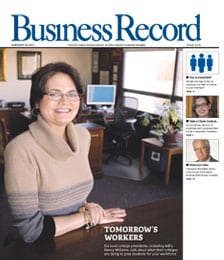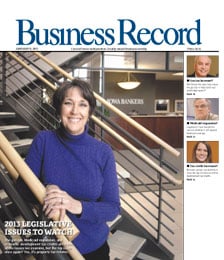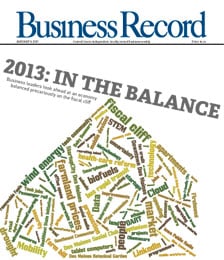Logic from the Prairie Fuels a breakthrough

Ames group says its virtual video reality technology can best IMAX
Don Pierce has done computer animation and special effects work for some of the top film studios in Hollywood, but it was a common fly that brought clarity to his idea for panoramic virtual-reality technology that swallows the viewer in the image.
Pierce is the founder of Prairie Logic Inc., an Ames-based technology company that on Monday will announce its breakthrough virtual video reality technology. Its creators say VVR, which immerses the viewer in live-action three-dimensional video and locks directional surround sound on the image, differs vastly from existing virtual-reality technologies, which are computer-generated and cartoon-like. Prairie Logic has patents pending on both the Experience Capture System, the camera-like devices that capture virtual experiences and environments, and the Experience Playback System, the hardware, software and display systems that play back virtual experience from DVDs.
Behind all the technical jargon is an immersive, 360-degree by 360-degree virtual experience that Pierce and his business advisers say could potentially best that offered in IMAX theaters.
BIRTH OF AN IDEA
“I have a horse ranch, and horse ranches have flies,” Pierce began the tale of how swatting flies helped him visualize the technology. “You can’t sneak up on flies.”
Flies and other insects with compound, multi-lens eyes integrate kaleidoscope-like images and see them as a single object. Providing the same immersive image through virtual-reality technology was as simple as figuring out the physics, Pierce decided.
Well, almost that simple.
Pierce, one of the early developers of 3-D computer animation, worked in the entertainment industry for 20 years and his name appeared on the credits for “All Dogs Go to Heaven,” “Rock-a-Doodle” and “The Pagemaster.” As one of six Wavefront Technologies freelance specialists worldwide in 1989, he helped develop a pioneering computer animation facility for Sullivan Bluth Studios. Other clients have included Walt Disney Co., Universal Studios, Turner Studios, SoftImage Inc. and NBC. He knew the production and technology requirements of the project, but needed additional expertise to bring it to fruition.
Pierce cherry-picked a team that included Iowa State University associate professor and Design Visualization Lab director Steve Herrnstadt, and ISU graduates Trent Grover, Brad Neuman and Fred Good, all of whom were involved in Iowa-based technology companies. He got management expertise from Growth Ventures, a Des Moines-based venture development group that has started or assisted more than 20 high-tech companies. Joe Stevens, Prairie Logic’s CEO, is chairman and co-founder of Growth Ventures. Joseph Meshi, Growth Venture’s CEO, who has more than 14 years’ experience assisting Fortune 500 companies, is helping Prairie Logic with business development and in establishing strategic relationships with possible corporate partners.
“I subscribe to the Henry Ford school of thought,” Pierce said. “I don’t have to know everything; I have to hire the people who do.”
THE BARRIER
Prairie Logic was incorporated in 2001. It almost faltered before it got started. Pierce and his team butted heads with a nasty law of physics related to stereo imagery – the same one that had caused Motorola Labs, which announced in August 2001 that it was on the verge of developing the same technology Prairie Logic is patenting, to retreat.
“The physics were impossible,” Pierce said. “We were in a deep, dark depression for a while.”
But as team members sat around Pierce’s deck brooding about the roadblock one summer evening in 2001, Good, the systems engineer, posed a rhetorical question that proved to be the company’s salvation. What if, he wanted to know, the step that was causing the problem were eliminated altogether?
It worked. Though initially funded on a shoestring $500,000 budget, Prairie Logic is now looking for another half-million dollars from angel investors and buyers for its technology and related products. The team meets in March with NASA officials, to whom they’ll pitch the idea of video virtual reality experiences of life aboard a space shuttle or of a Mars exploration. Custom applications have been developed by Prairie Logic for military, industrial and corporate clients, and include training, promotional marketing and high-end real estate presentations. Pierce expects the technology to eventually have broad applications in fields such as travel, entertainment, education, relaxation and medicine, and, as bandwidth increases, in real-time applications.
Home applications are still several years in the future, but Pierce is optimistic. “Imagine putting a DVD into your PC or game console or attending a concert of a famous musician after the artist has retired, or participating in an extreme sport, or experiencing the depths of the sea – from the comfort of your home,” he said.
WHERE TO NEXT?
Carolina Cruz-Neira, an associate professor of industrial and manufacturing systems engineering at ISU and associate director of the university’s Virtual Reality Applications Center, predicts a bright future for the company, which this spring will accept an invitation to move from its downtown Ames office to the ISU Research Park, a rapidly growing technology community of more than 45 companies. Cruz-Neira is asked to provide advice to hundreds of technology companies each year, but she accepted the invitation to serve on the advisory board of Prairie Logic and only one other company.
“They have very interesting technology, which from my point of view complements very nicely a lot of computer animation and virtual-reality work being done today,” said Cruz-Neira, proclaimed by BusinessWeek in 1997 as a “rising research star” in the new generation of computer science pioneers, a 2000 winner of the Iowa State Foundation Award for Early Achievement in Research and a 2001 winner of the Boeing A.D. Welliver Award.
“They can capture live images and make them 3-D immersive, which is wonderful technology to stand alone or blend with others,” she said. “Their technology could generate a high-quality, exciting backdrop for a particular game, environment or educational experience.”
The company has tremendous potential, especially in entertainment applications, she said. The technology Prairie Logic pioneered goes a step beyond IMAX, billed as the world’s most powerful and involving film experience, with images up to eight stories high and wrap-around 12,000-watt digital sound.
As Prairie Logic develops, it will lease its Experience Capture System, harvest the digital video and acoustic experiences and process them using extensive algorithms, and collect a royalty each time they are shown, which Meshi says has the potential to put it in the same league as industry giants such as IMAX, Panavision and Kodak.
“I don’t see a real reason why we can’t be the same size,” he said. “I project this will be a multi-hundred-million-dollar company.”







